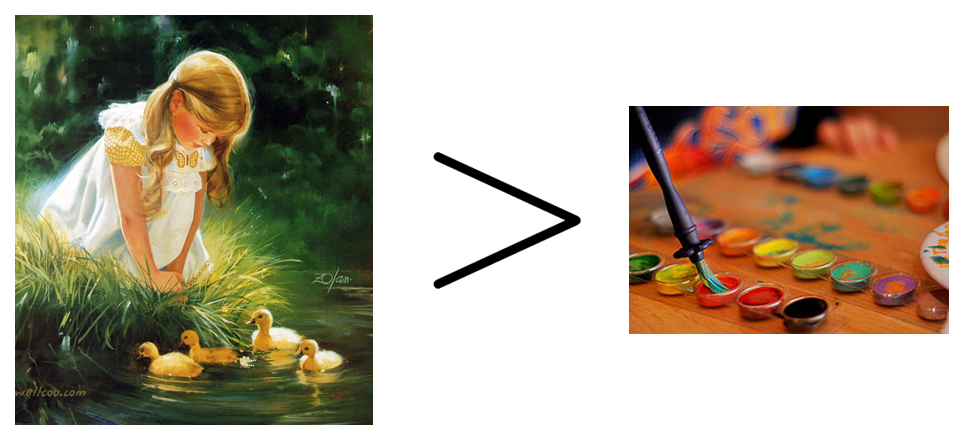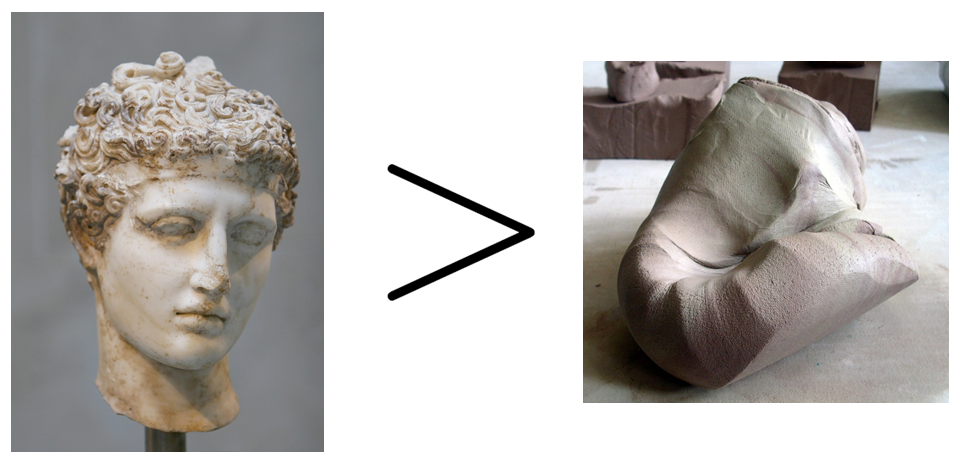|
I'm completely unfamiliar with art, but I've had this interesting thought lately. First of all, Art is more than the sum of its parts. (Statement 1) There are many ways how an art piece can be more than its constituents. The visual arts give a few easy examples, where emotion can be injected into a medium (the "sum of its parts"). The emotion, message, or whatever special qualities that qualify something as art, was not present in the medium itself, yet it present in its final form. Folding a piece of paper using origami can lead to expressive paper sculptures, but we can also create supremely complicated works, especially in representational origami. This may not necessarily involve a lot of emotion, but it is still something interesting that the folder injects into the paper. Perhaps a more unexpected example would be how a fine piece of cooking is more than the sum of its ingredients. I like to think that good cuisine is defined by a the mutual complementing of the tastes of ingredients, seasoning and various textures, as well as the aesthetic display of the final dish. Of course, this description is not limited to the visual arts; a symphony, or even an advertising jingle, is obviously more than a bunch of notes strung together. These examples are all that I care to mention before I move on to my main thesis: Art is the difference between the whole and the sum of its parts. (Statement 2) What I mean is that art is the "magic quality" that artists inject into their medium. What's weird is that we can turn this into an algebraic metaphor: $$\text{Art}(\text{whole}) = \text{value}(\text{whole}) - (\text{value}(\text{part}_1) + \text{value}(\text{part}_2) + \dotsb)$$ where $\text{Art}(x)$ is the "amount of art" in object $x$, $\text{value}(x)$ is the "amount of experience derived from" $x$ (e.g. emotion, sensory stimulation, etc), and $\text{whole} = \text{part}_1 + \text{part}_2 + \dotsb$. I hate making disclaimers, but I must assure you that I do not think art and experiences can be quantified by such a terribly lossy compression into a single number (but see the remark in the final section); this is merely a metaphor. Measure of distributivityWhat is the mathematical significance of this metaphor? In Abstract Algebra, we can have sets of objects and define how we can "multiply" them together to produce objects in the same set. That definition can be quite different from what we are used to; in fact, sometimes it is not commutative, i.e. $xy \neq yx$. A commutator is a binary operation that measures "how commutative multiplication is". Sometimes we define it as $$[x, y] = x^{-1}y^{-1}xy$$ which is obviously equal to $1$ if $xy = yx$. Sometimes it may be useful to define it as $$[x, y] = xy - yx$$ which also "vanishes" only if $xy = yx$. However, we're not only interested about the times when $xy = yx$; sometimes, the "defect value" $xy - yx$ is useful. Apparently, this value is related to Quantum Physics, where it represents how well quantities $x$ and $y$ (e.g. momentum and position) can be measured simultaneously. This leads to the famous Heisenberg Uncertainty Principle. Another property in Abstract Algebra that is as important as commutativity is distributivity; in a general setting, a function $f(x)$ may distribute over a sum: $$f(a + b + c + \dotsb) = f(a) + f(b) + f(c) + \dotsb$$ A familiar example would be how multiplication distributes over addition: $$k \times (a + b + c + \dotsb) = ka + kb + kc + \dotsb$$ Readers familiar with Number Theory can also consider the example of multiplicative functions, which distribute over multiplication. Statement 1 is then analogous to $$\text{value}(\text{whole}) > \text{value}(\text{part}_1) + \text{value}(\text{part}_2) + \dotsb$$ If both sides were equal, the "$\text{value}$" function would distribute over "$\text{whole}$", and the situation would be artistically quite boring. Hence, the "defect value" is of interest, which brings us to statement 2: $$\text{Art}(\text{whole}) = \text{value}(\text{whole}) - (\text{value}(\text{part}_1) + \text{value}(\text{part}_2) + \dotsb)$$ The "defect value" $\text{Art}(\text{whole})$ measures how well (or how badly) the $\text{value}(x)$ function distributes over a sum of parts. Consequently, the "greater" the defect, the more art was injected into the medium, and the better the art piece is. Strange examples pop into my head and refuse to leave, so here's one: \begin{multline}\text{Art}(\text{chicken rice}) = \text{value}(\text{chicken rice}) - \text{value}(\text{chicken}) - \text{value}(\text{rice})\\ - \text{value}(\text{chilli sauce}) - \text{value}(\text{oyster sauce veggies}) - \dotsb\end{multline} Another example, this time from Chemistry: $$\text{Art}(\text{Glucose}) = \text{value}(\text{C}_6\text{H}_{12}\text{O}_6) - 6 \cdot \text{value}(\text{C}) - 12 \cdot \text{value}(\text{H}) - 6 \cdot \text{value}(\text{O})$$ A caveatI suspect, since I am as yet ignorant, that artistic experience cannot be considered completely independent from the medium. Part of the expressive potential of each medium should be inaccessible from other media. That is, some art pieces cannot be satisfactorily reproduced in another medium. This isn't a problem, it just means that each medium has a unique range of things it can express, to various degrees of success. The only evidence I can offer comes from the only art form I have a fleeting knowledge of: There's something about the plane, and that there's only so many ways that you can push or pull it around, that constraint is quite different from other mediums. There's no carving in wood, or in stone, or knots on a rug, that's gonna look anything near like what pleats do, when they express a line. Art as dataFew would doubt that artistic value cannot be compressed into a single number and compared with values of other art pieces. However, some hold the view that art is no more than the experience it brings (e.g. a real diamond and fake diamond are equally good if no expert in the world can tell the difference), and that experience is no more than the sum of the sensory information our brain receives. From this perspective, art can be coded as sound waves (like an MP3 file) or visual data (like a movie). Do you agree?
0 Comments
Leave a Reply. |
Archives
December 2020
Categories
All
|




 RSS Feed
RSS Feed